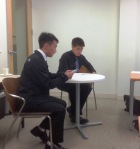The Internet has given each of us access to millions of times the information of a single library, at our very fingertips. The Internet is an institution that is conducive to future stability and growth, yet its implementation has changed the way we think about information forever. The memorized lessons of our culture are now a 5 second search away.
Information and the speed at which it is transmitted around the world has changed dramatically with the modern Internet. Millions of dollars that were once spent on radio and TV campaigns are instead being spent on the Internet. Millions of pieces of mail that were once sent by paper and stamp are now beamed electronically for free. In the 1930’s, Franklin Delano Roosevelt began addressing the nation directly with his Fireside Chats radio show. Today, Barack Obama hosts his own Fireside Hangouts on Google+.
The Internet has changed geopolitics forever by intricately connecting people across the whole world. For example, when an airstrike occurs in the Ukraine, I have access to video footage minutes afterward. Imagine how different the world would be if video footage of Hiroshima and Nagasaki had been made available minutes after it happened. We are truly in an information exchange renaissance where ideas can be blasted simultaneously to nodes around the world at the speed of light, and it already has changed the way we do almost everything.
With this in mind, on March 5, the student ambassadors did a Face to Faith video conference with Dian Didaktika Islamic Senior High School in Indonesia. Exchanging information and valuable insight across different cultures gave everyone a wider perspective of the world and the people around them. During the video-conference, we learned about the school system in Indonesia, shared our international experiences and discussed our future career plans. Two students even connected through their study of Japanese and starting a Japanese club! With the internet, we could easily connect, make friends, and unite across the globe.
By Vivian Kwan, Student Ambassador, Westmoor High School
Face to Faith works around the world to connect students of different faith in conversation. Please visit facetofaithonline.org to learn more and involve your students.







